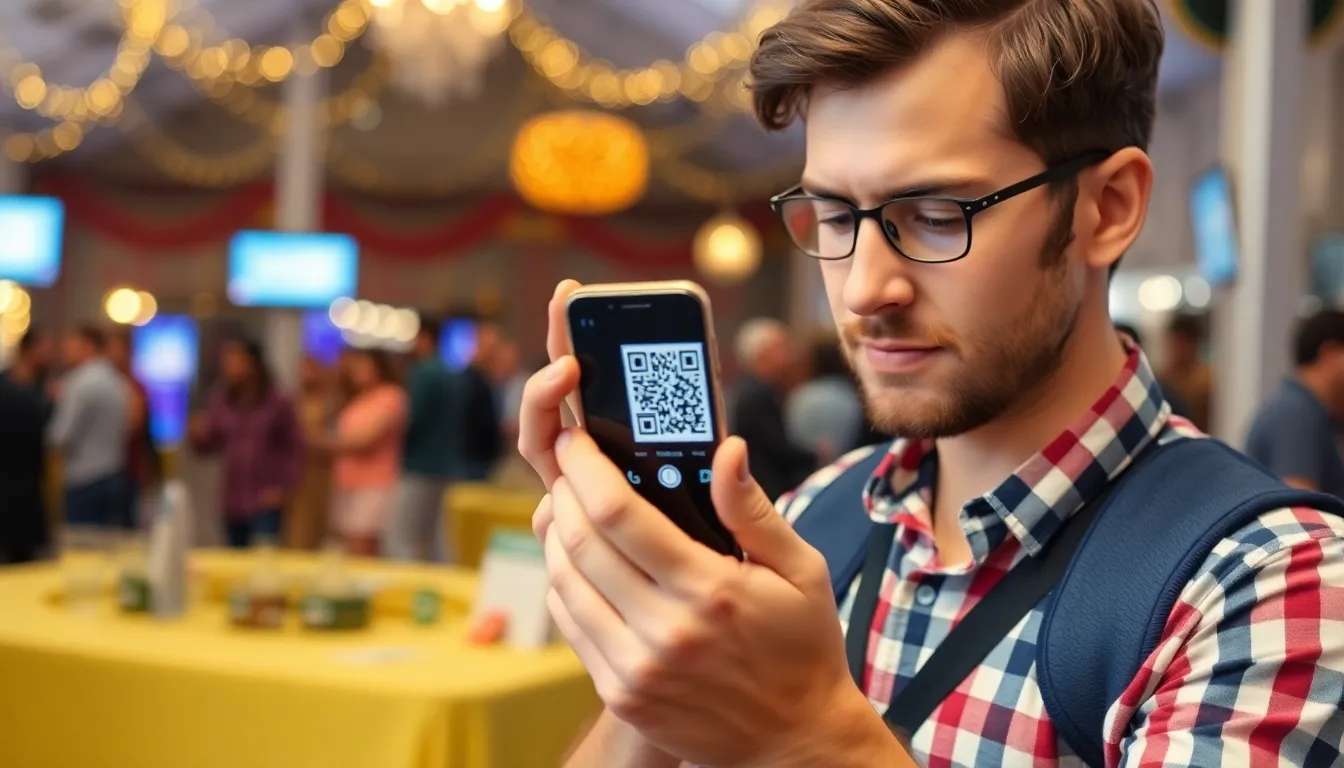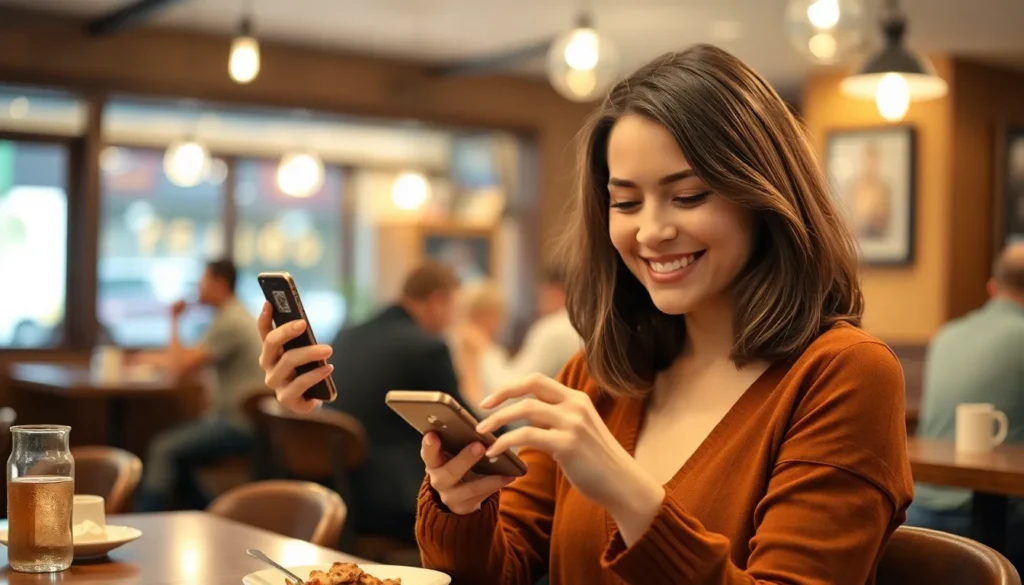In a world where everyone’s glued to their screens, QR codes have become the secret handshake of the digital age. They’re popping up everywhere—from restaurant menus to concert tickets—and they’re just begging to be scanned. But what if you’ve snapped a pic of a QR code instead of scanning it live? Fear not!
Table of Contents
ToggleOverview of QR Codes
QR codes, or Quick Response codes, emerged in 1994, providing a more efficient way to access information than traditional barcodes. Many industries utilize these codes to streamline processes and enhance customer engagement. For example, restaurants now display QR codes on tables, allowing patrons to view menus without physical copies.
Individuals often encounter QR codes in various settings, such as advertisements, tickets, and product packaging. These codes contain encoded data, which can include URLs, text, or contact information. Scanning a QR code typically directs users to an online resource or provides essential information instantly.
Smartphones play a significant role in accessing QR codes. Most devices now come equipped with built-in camera functionality that supports direct scanning. Users can scan a code by simply pointing their camera at it, making the process user-friendly. When someone captures a photo of a QR code instead of scanning it directly, alternative methods are available to retrieve the encoded information.
In terms of functionality, QR codes offer several advantages. They can hold significantly more data than traditional barcodes, making them versatile for various applications. Additionally, QR codes maintain their readability even if partially damaged, enhancing usability in everyday situations.
Adoption rates have increased, driven by the COVID-19 pandemic, as businesses embraced touchless solutions to minimize contact. With their growing presence in daily life, understanding how to interact with QR codes, including scanning from photos, becomes increasingly essential.
Importance of Scanning QR Codes in Photos

Scanning QR codes in photos offers significant convenience in the digital age. Many people capture images of QR codes for quick access to links, tickets, or menus. Smartphones enable easy retrieval of this information stored in photograph form.
Efficiency stands out as an advantage, particularly when users encounter a QR code in a fleeting moment. Capturing a photo allows individuals to revisit the code later for scanning purposes. This practice minimizes the risk of losing physical copies of important codes.
Time efficiency improves as well, since searching for a specific code in a gallery takes less time than locating it physically. In fast-paced environments, such as during events or travel, having a photo of a QR code ensures timely access to vital information.
Businesses gain benefits from this trend too. Users are more likely to scan QR codes that they previously captured in photos rather than letting them go unnoticed. This increased engagement leads to higher interaction rates with digital content.
Embracing the habit of scanning QR codes in photos fosters greater user engagement. As individuals rely more on smartphones, retrieving codes from images will continue to gain importance. Ultimately, scanning these codes contributes to efficient communication and information sharing in various sectors.
Methods to Scan QR Codes in Photos
Scanning QR codes embedded in photos is straightforward. Several effective methods are available.
Using Smartphone Cameras
Smartphone cameras frequently serve as handy tools for scanning QR codes. Users can open their camera apps and point them at the QR code within the photo. A notification typically appears at the top of the screen if the code is readable. Tapping the notification directs users to the encoded URL or information. Many smartphones also allow users to select images from their photo galleries for QR code scanning, offering convenience and flexibility. Adjusting the camera’s focus may enhance readability, ensuring a seamless experience when accessing information quickly.
Using QR Code Scanner Apps
Numerous QR code scanner apps enhance the scanning process significantly. These specialized applications often come with features tailored to improving accuracy and functionality. Users can import images directly from their photo libraries for scanning. The app analyzes the image and retrieves the encoded data swiftly. Some apps even offer history features, allowing users to track previously scanned codes. Popular QR scanner applications include QR Code Reader and NeoReader, which provide intuitive interfaces. Selecting a reliable app can maximize efficiency, allowing users easy access to necessary information.
Step-by-Step Guide to Scanning QR Codes
Scanning QR codes from photos is straightforward. Most smartphones offer efficient ways to accomplish this task, ensuring users never miss out on encoded information.
Identifying QR Codes in Photos
Identifying QR codes in photos starts with visual recognition. Users scan their camera roll for images containing QR codes. Clear images show distinct black squares arranged in a grid pattern. Focusing on high-resolution images enhances visibility, helping users spot codes quickly. Zooming in can also reveal QR codes obscured by shadows or reflections. When found, it’s essential to ensure the code appears intact, as damage may impede scanning.
Utilizing Built-In Features
Utilizing built-in features makes scanning seamless. Many smartphones include a QR code scanner within the camera app. Users simply open the camera and point it at the QR code in the photo. Notifications then appear, guiding users to access the linked content. Some devices allow users to tap the photo sharing options, simplifying the scanning process. For even more convenience, certain operating systems support recognizing QR codes directly from images in their gallery. Embracing built-in features eliminates the need for third-party applications in most cases.
Troubleshooting Common Issues
Scanning QR codes in photos can sometimes lead to issues. Users may face problems due to poor image quality. Blurry or low-resolution images complicate the scanning process. Ensure the photo of the QR code is sharp and clear for best results.
Lighting conditions also play a role. Dark or overly bright images can obscure the QR code’s features. Adjusting the lighting before taking a photo can improve the outcome significantly. Natural light often yields better results than artificial lighting.
Another common issue arises from partially obstructed codes. If any part of the QR code is hidden or damaged, it may not scan properly. Users should try to capture the entire QR code within the frame to avoid this problem. Focusing on capturing undistorted images helps maintain the code’s integrity.
Some smartphones fail to recognize QR codes from images instantly. Users can find success by using dedicated QR code scanner apps. Many apps allow users to import images from their gallery for manual scanning, increasing the chances of successful retrieval.
Users might encounter incorrect links even after scanning a code successfully. It’s crucial to verify the link or the information provided. Some QR codes may direct to outdated or inactive resources, so double-checking ensures access to accurate content.
Lastly, avoid using third-party apps that lack good reviews. Reliability is essential when selecting an app for scanning QR codes. Opting for well-reviewed, popular apps like QR Code Reader or NeoReader increases functionality and user satisfaction.
Mastering the art of scanning QR codes in photos is a valuable skill in today’s tech-driven world. As QR codes continue to permeate various aspects of life it’s essential for users to leverage their smartphones effectively. With built-in camera features and dedicated apps scanning codes from images can be quick and effortless.
By understanding the best practices for capturing and scanning these codes users can enhance their digital experiences. This not only streamlines access to information but also promotes greater engagement with businesses and services. Embracing this practice will undoubtedly pave the way for more efficient communication and information sharing in an increasingly digital landscape.




